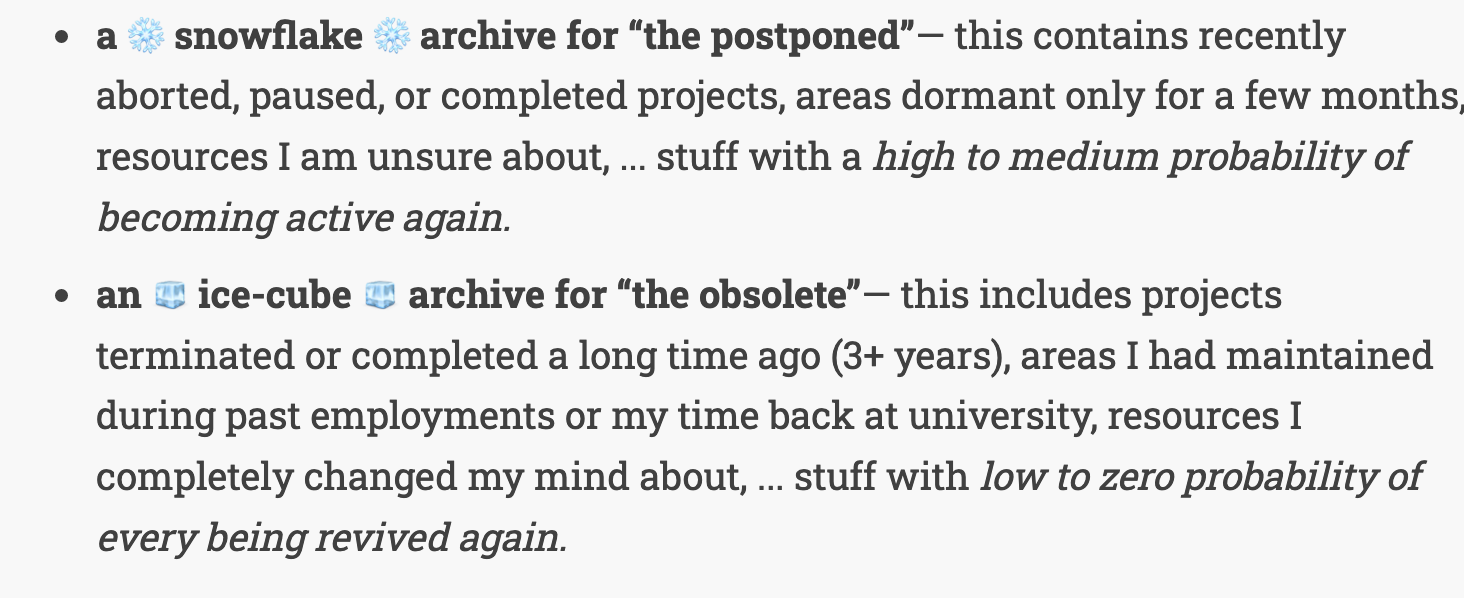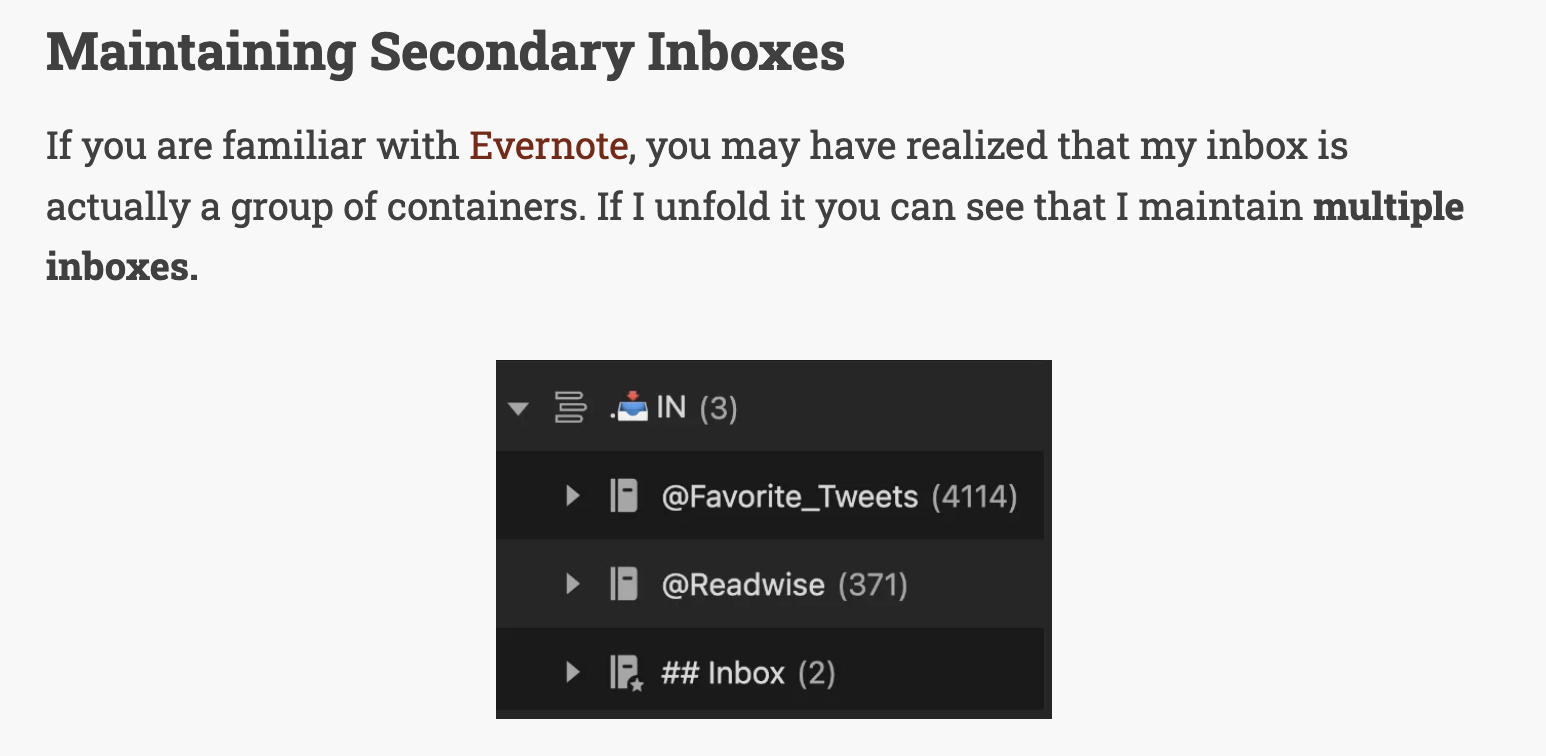Extending Para Notes
PARA - organize things by actionability Its organization is based on a spectrum from hot (more timely, relevant) to cold (less timely, relevant).
an “organizational system for your whole digital life”.
Areas has containers for contemporary life areas (these are domains like health, work, or family, where you have long-term responsibilities and/or want to maintain a certain standard)
Resources has containers for each of your topics of interest (this is usually for more long-term reference materials)
WIP stands for “Work In Progress”. It refers to the number of unfinished items at a given place at any given time.
limit the number of containers within each P.A.R.A. space. 7 projects, 21 areas, and 21 resources
-
I increase the project throughput (while before I would collect more projects without making progress on any of them)
-
I am forced to cancel ill-born projects (while before I would keep zombie projects alive)
-
I reduce congestion & bottlenecks (while before I would keep too many never-ending projects)
-
I review my life areas more often (while before I would only add new areas but never retire old ones)
-
I am forced to focus on the essential few (while before I would lose focus by adding too many items)
-
I do more house-keeping of my resources (while before I would accumulate a never-ending pile of new references)
by adding custom spaces you also risk its potency and clarity.

How to deal with bigger and hot topics that span several projects?
These “epics” are often too “hot” or short-lived to count as areas. They are also way too big to be just a single project. And if it’s multiple related projects, how do I represent their connectedness and priority over everything else?
Whenever I run into these situations, I create what I call a personal program.
That’s the name I give highly concentrated multi-project endeavors that last a couple of weeks to a few months and require all of my energy (next to my day job).
a program is a bundle of related projects, areas, and resources you are working on almost exclusively for many work sessions. Comment: Also nicely relates to programs in a company
tackle one of them I create a temporary “hotter-than-project” space. So I’d go from P.A.R.A. to P.P.A.R.A.. I’d do that only for the time of the program and then revert back to P.A.R.A. after the program is finished.
1 — The program space is more actionable than your projects, so it should be sorted/located before projects. It should at least somehow stand out and give the impression of being more important than your projects.

Tagging
In Tagging is Broken Tiago Forte points out that tags are ill-suited to replace folder hierarchies.
Tagging systems won’t replace folder hierarchies, that’s right. But they can very well supplement them.
Recommendations when working with Tags
- reduce the upfront decision cost as much as possible
- “tagging triggers” woven into your workflows that tell you it is time to tag
- remove the need to memorize tags
- tool creates tags for you completely automatically. Or some templates bring them in by default and you removed the ones not needed
-
- use tagging conventions 2. use tagging hierarchies 3. use auto-complete features
- separate tags from content and let tags evolve naturally
- review & consolidate your system opportunistically
- strive to make every tag count
- choose a lightweight, antifragile approach to tagging
His examples

Meta
- Containers growing too large for efficient navigation
- Lacking an overview by item type. What if you need an overview of all your book summaries or list all the checklists you have ever created?
About capturing
Source A solid capture habit is worth a lot, but it can lead to a problem. It makes us prone to over-capture; to keep more than we are able to use.
Use a heuristic like “when in doubt, discard it.”
To create my safe area / someday maybe empire I added a 5th space to my P.A.R.A. I called it my “incubator” since stuff there is lingering and waiting to be born. Comment: I achieve that my taking smart notes and adding such things to fleeting notes that I will then further process.
About Inbox management
Source That’s why I deem it legit to consider the inbox as a hidden space of P.A.R.A. (think i.P.A.R.A.)
Comment: I actually using my Fleeting Notes folder as my inbox and this works just fine and is in alignment with [[How to Take Smart Notes]].

Some advanced users may be able to actually ever only inbox triage opportunistically based on how they feel about the current contents.
A third way you can approach it is what I call Inbox Kanban. Here you triage based on the number of items the inbox contains.
Linking
Notes mentioning this note
There are no notes linking to this note.